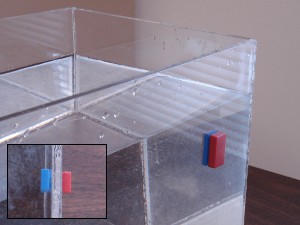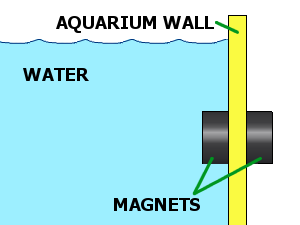Guide to Aquarium Magnets
How to use reef safe plastic magnets to hang coral, rocks and other fish tank accessories

Neodymium magnets are used in aquariums for their ability to attract to one another through aquarium walls, without requiring a hole in the wall. Here are some of the answers to the questions we most commonly receive about using powerful magnets in an aquarium.
Most setups consist of two magnets attracting towards one another, with one inside the tank walls and one on the outside. We'll consider this setup for most of the discussion below.
Will magnets work underwater?
Yes, magnets attract to one another underwater. The biggest concern with using neodymium magnets underwater is corrosion. In the presence of moisture, neodymium magnets can rust about as fast as a piece of raw iron. While the nickel plating does slow this down, the nickel eventually loses the battle.
Do not put unprotected magnets into your aquarium! Corroding, rusting magnets may harm aquatic life.
The best strategy is to seal off the magnet somehow from the water. While some of our customers seal off our magnets themselves, either potting them in place or encasing them within their own assembly, our Plastic Coated Magnets are a great off-the-shelf solution.
Plastic Coated Magnets have a layer of injection molded plastic that surrounds them, providing a waterproof seal. Most of these magnets use a 1/32" thick layer of polypropylene plastic.

Designed to prevent rust and leaching for a safe reef and aquarium setup
Shop NowDo not use our Rubber Coated Magnets underwater. The natural rubber can have tiny pinholes, and may deteriorate over time.
What size magnet do I need?
Disclaimer: What size magnet you need really depends on how you use the magnets. The remainder of this article are some good suggestions and guidelines, but you will really have to try it out yourself to see what works in your exact application. Sometimes differences in how you use a magnet can have a big effect on their performance.

There are 2 important factors to consider: How much strength is required? How thick are the walls of the aquarium?
For most applications, we find that a magnet pull force of 1-3 lb is about right. At least, that's true for the aquarium wall cleaners and coral frag holders we've worked with.
The key to choosing the right magnets is knowing the wall thickness the magnets reach through. The farther apart a pair of magnets is from one another, the weaker the force between them. Magnets that work great on a small 10-20 gallon tank with 1/8" walls will be much too weak for a bigger tank with 1/2" thick walls.
To help narrow down your search, we've compiled a list of plastic coated magnets, arranged by strength. In the table below, you can see which magnets might be best for various wall thicknesses.
| Aquarium Wall Thickness (inches) | |||||||
| Part Number | 0.125 | 0.25 | 0.375 | 0.5 | 0.625 | 0.75 | 1 |
| D68PC-RB | 1.13 lb | 0.48 lb | 0.27 lb | 0.11 lb | 0.06 lb | 0.03 lb | 0.01 lb |
| D84PC-BLK | 1.39 lb | 0.58 lb | 0.27 lb | 0.14 lb | 0.07 lb | 0.04 lb | 0.01 lb |
| D8APC-BLK | 3.07 lb | 1.53 lb | 0.84 lb | 0.49 lb | 0.29 lb | 0.18 lb | 0.07 lb |
| B888PC-BLK | 3.7 lb | 1.88 lb | 1.04 lb | 0.61 lb | 0.37 lb | 0.23 lb | 0.1 lb |
| BX084PC-BLK | 3.82 lb | 1.89 lb | 1.02 lb | 0.59 lb | 0.35 lb | 0.21 lb | 0.09 lb |
| RX034DCSPC-BLK | 5.82 lb | 3.06 lb | 1.75 lb | 1.05 lb | 0.65 lb | 0.42 lb | 0.18 lb |
| DC6PC-BLK | 5.87 lb | 3.16 lb | 1.85 lb | 1.13 lb | 0.72 lb | 0.47 lb | 0.21 lb |
| RX436DCSPC-BLK | 14.75 lb | 9.13 lb | 6.02 lb | 4.12 lb | 2.89 lb | 2.07 lb | 1.11 lb |
| BX8C6DCSPC-BLK | 16.78 lb | 10.55 lb | 7.05 lb | 4.88 lb | 3.47 lb | 2.51 lb | 1.38 lb |
| BX0X08DCSPC-BLK | 17.89 lb | 11.39 lb | 7.69 lb | 5.38 lb | 3.86 lb | 2.82 lb | 1.57 lb |
| BY0X08DCSPC-BLK | 29.93 lb | 20.46 lb | 14.7 lb | 10.88 lb | 8.23 lb | 6.31 lb | 3.86 lb |

A word about what these numbers mean: The calculated pull forces shown above are the force required to pull one magnet straight away from the surface of the wall. The force required to push the magnet down the wall is less than this number. The actual value depends on the friction between the surfaces, but we usually estimate half of the values listed above.
For example, a pair of small D84PC-BLK magnets on either side of a 1/8" thick glass wall should hold with a force of about 1.39 lb. This means it takes 1.39 lb to pull one magnet away from the wall. How much force will it take to slide the magnet down the wall? If we estimate half that value, that would be about 0.7 lb.

Great for hanging coral, rocks and accessories in your aquarium without rust and leaching
Shop NowYou can also get greater strength by stacking magnets. For example, if you stick a stack of 2 magnets on one side of the glass, attracting to another stack of 2 magnets on the other side of the glass, you'll feel more strength.
Real World Experiments
Here is a brief demonstration of a few plastic coated magnets, which gives an idea of their relative strength. The walls of this tiny test aquarium are 5mm (0.197") thick acrylic.
Can magnets hold up a shelf?
Again, it depends. While every situation is different, here are a few things to think about when designing a magnetic shelf.
With a shelf, the shelf's depth provides more leverage to pry the magnets away from one another. The deeper the shelf, the easier it is to pry the magnets loose.

For this reason, most shelves are kept fairly narrow, not extending too far into the aquarium. This is especially true for shelves that will support a heavy load, such as a number of coral frags.
For most shelves, using multiple magnet pairs with some vertical separation between them is the key to getting a successful hold without using excessively large magnets. In the picture at right, note the distance between magnet pairs, which gives the magnets some leverage against the load on the shelf.
For a thorough, theoretical look at how this works, see our PDF shelf drawing of calculations, which includes a practical example.
If you have any other questions about using magnets in your aquarium, please contact us!


